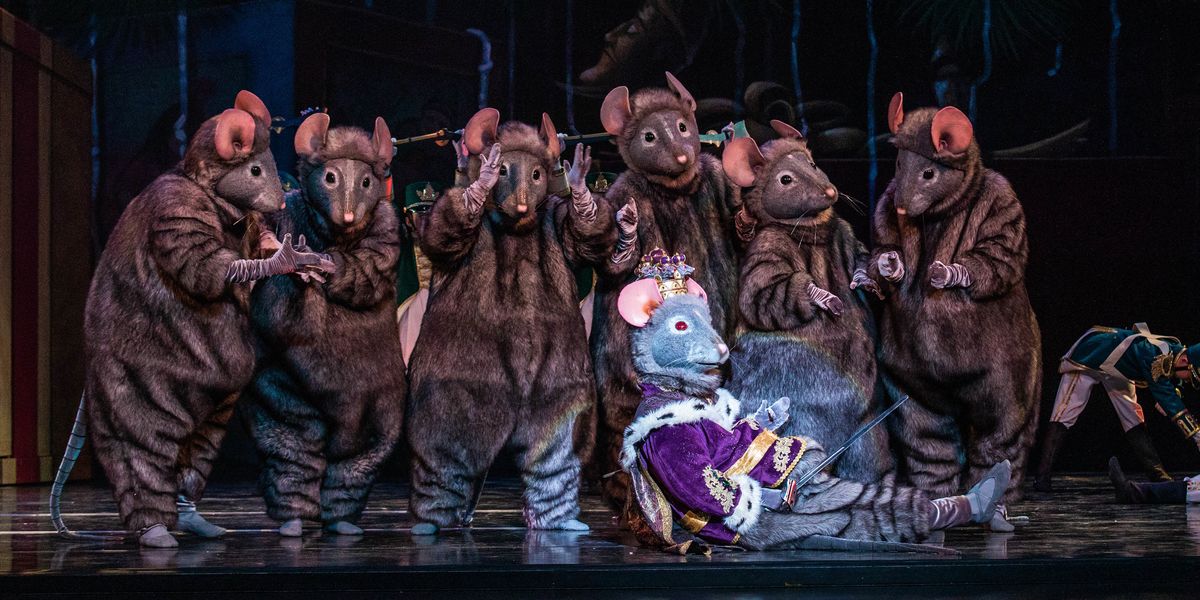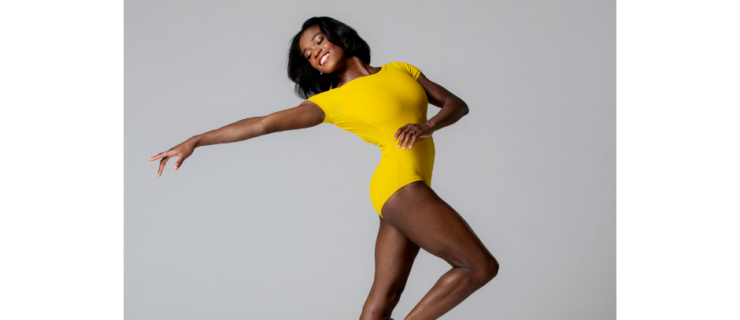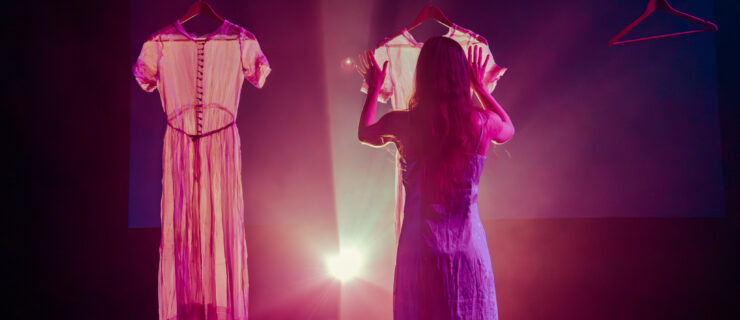Land of the Bittersweet: COVID's Effect on Nutcracker
To some dancers, a winter without The Nutcracker may seem like a gift. No Tchaikovsky on an endless loop. No missing real parties to dance in the party scene. No pulling fake snow out of your hair. It’s the stuff that burned-out ballerinas might dream about in mid-December.
But, true to E.T.A. Hoffmann’s original “Nutcracker and Mouse King,” sometimes gifts are broken, and dreams are not as they seem. The COVID-19 pandemic has forced companies into nightmare scenarios to keep audiences and dancers safe: canceling or rethinking entire seasons, including the hallmark Nutcracker.
Financially, artistically, logistically—and let’s face it, emotionally—dance companies are faced with the unthinkable. Can companies survive without The Nutcracker? We’ll find out this year.
Dark Stages, Broken Budgets
In the ballet world, Nutcracker is an essential business. The ballet brings in an average of 48 percent of total performance revenue (an average of $2.8 million in ticket sales) for a year, according to a Dance/USA survey on 24 member companies’ 2017–18 seasons. It’s typically the most lucrative production in a season.
That revenue does more than pay salaries and electric bills. Companies rely on Nutcracker money to commission new works and experiment with productions that don’t have a built-in reputation at the box office. “Nutcracker is very important to the full revenue cycle of a dance and ballet company,” says Amy Fitterer, executive director of Dance/USA.
“Nutcracker is the only production that produces any revenue—everything else loses money,” says Mikko Nissinen, artistic director of Boston Ballet. In 2019, Boston Ballet’s 41-show Nutcracker season brought in more than $8 million in gross revenue, according to a company representative. In lieu of a live Nutcracker, this year Boston Ballet will broadcast excerpts from past performances on NBC Boston on November 28—but the broadcast partnership won’t contribute to ticket-sales revenue.
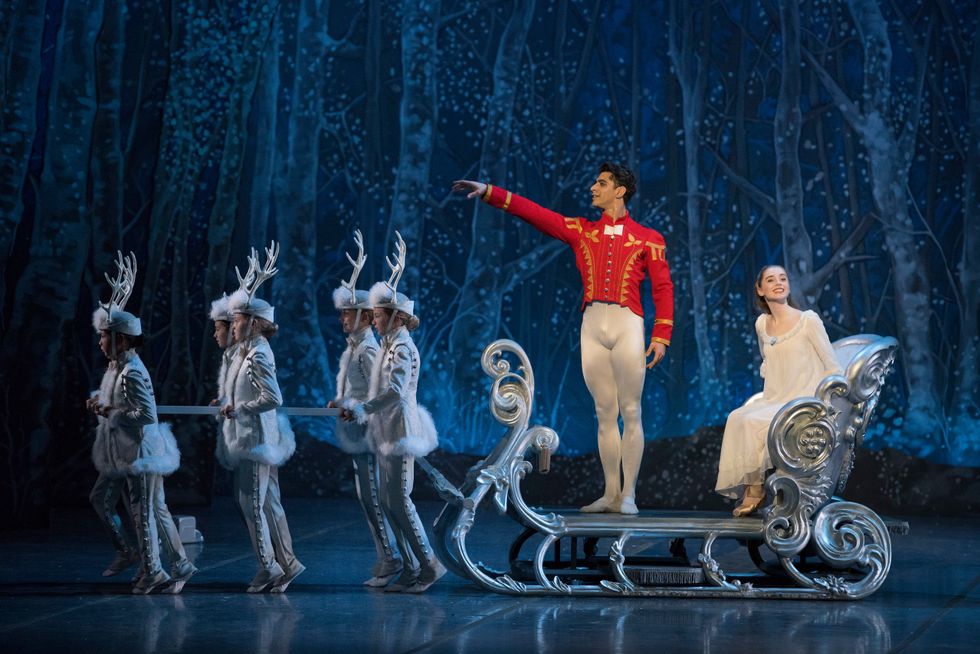 Tigran Mkrtchyn and Mia Steedle
Tigran Mkrtchyn and Mia Steedle
Liza Voll, Courtesy Boston Ballet
Every company, from those that put on glittering big-city productions to the community studio that rents a high school auditorium, will feel the financial strain. Even the iconic New York City Ballet production of George Balanchine’s The Nutcracker is a victim. Since its premiere in February 1954, it’s been a mainstay of the company, bringing in $15.3 million last year. NYCB has already taken out millions of additional dollars from its endowment this year to make up for the revenue lost from the canceled spring season, and The Nutcracker will be an even bigger hit.
Companies without this cushion face dire financial consequences. Since the pandemic began, major companies have furloughed dancers and staff and cut salaries and expenses to stay afloat. They’ve established emergency-relief funds to provide immediate support and cover health-care costs for dancers. Subscribers donated tickets back to companies. And all this happened before Nutcracker came into the picture.
Many small-town studios have tried to make do with less. “It all comes down to economics,” says Dan Guin, executive and co-artistic director of Boca Ballet Theatre, a pre-professional ballet company in Florida. “Even if we were able to get into a venue, would people even go to a show? Is it even cost-effective to do that?”
Crafting New Traditions
Though Balanchine’s Nutcracker may be the most recognizable today, America’s “first” Nutcracker was set by Willam Christensen on San Francisco Ballet in 1944. Today, Ballet West performs Christensen’s version, and holds the unofficial title of “oldest Nutcracker in the country,” with an unbroken 75-year run. They don’t want COVID-19 to end it.
“So many companies rely on Nutcracker, but ours is part of our history,” says Adam Sklute, artistic director of Ballet West. With its legacy at stake, Ballet West has bold Nutcracker plans: adding more performances to the run so smaller audiences can maintain social distance in the theater.
Pulling this off requires “complicated casting measures,” like putting dancers into “pods” that rehearse and perform together to minimize contact, Sklute says. Not to mention the finances required to pay dancers and staff for more shows.
“Ballet companies have been working to keep ourselves relevant for years,” Sklute says. “Now more than ever we have to be even more creative in the way that we approach our art form.”
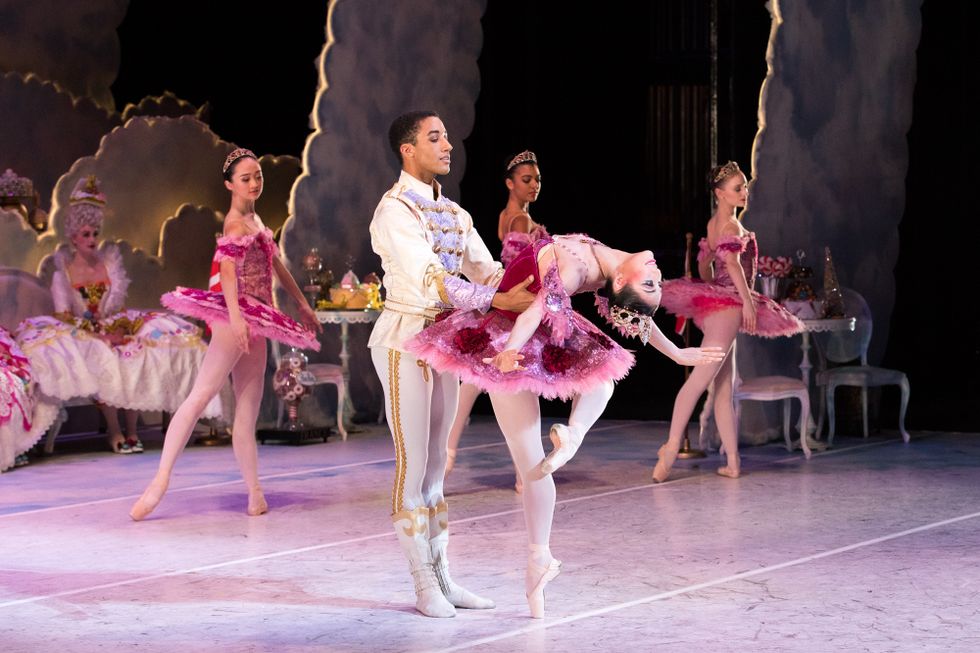 Houston Ballet’s Harper Watters and Soo Youn Cho
Houston Ballet’s Harper Watters and Soo Youn Cho
Lawrence Knox, Courtesy Houston Ballet
For some companies, going virtual is the safest route. Pacific Northwest Ballet’s all-digital pay-per-view season includes a special video presentation of Balanchine’s Nutcracker. Boston Ballet’s virtual season, BB@yourhome, will include divertissements set to Duke Ellington’s Nutcracker Suite, as well as the grand pas de deux.
Julie Kent, artistic director of The Washington Ballet and former American Ballet Theatre principal, couldn’t stomach the thought of canceling The Nutcracker without an alternative. “I am a dancer, first and foremost, and that would be, like, artistic suicide to me,” she says. (The company will present Nutcracker and the rest of its winter 2021 season online.)
Others are seizing the opportunity to think beyond the Land of the Sweets. With its strong classical backbone and widespread appeal in pop culture, “Nutcracker is the most flexible of all ballets,” says Jennifer Fisher, author of Nutcracker Nation. The ballet can handle changes, and it “has the ability to reflect culture as it develops,” she says. Just look at Austin McCormick’s burlesque Nutcracker Rouge and Disney’s The Nutcracker and the Four Realms for proof.
As of press time, Sarma Lapenieks Rosenberg, artistic director of Anaheim Ballet, was considering choreographing a contemporary interpretation of the full-length ballet with solos and a condensed cast, which could be toured in the future. “If we can hold on to the essence and the deeper meanings to sections of Nutcracker, we can keep the spirit alive even in these circumstances,” she says.
Cincinnati Ballet planned to present a shortened, hour-long Nutcracker with “all the highlights” that could be performed in a smaller venue with social distancing and no intermission, explains artistic director Victoria Morgan, who choreographed the company’s Nutcracker in 2011. In November, the company decided to record a performance and present it online, rather than in-person. Amid all of the cancellations, “it’s really a riot to actually be working on Nutcracker,” a show that’s typically put on autopilot, Morgan says. “Thinking of dancers moving on a stage right now is just one of the most pleasant thoughts.”
When Houston Ballet made the decision in July to cancel The Nutcracker, artistic director Stanton Welch got to work planning “a fun Christmas Houston Ballet extravaganza” to be performed in December instead, he says. In addition to excerpts from The Nutcracker, there will also be solos and pas de deux set to classic holiday songs.
“There’s a lot of great Christmas music we don’t get to choreograph to because we’re always doing Nutcracker,” he says. “I’d love to do a small parody of Clara visiting her grandparents through the window, at a Christmas party—why not?”
Welch has experience reworking a troubled season. When Houston Ballet’s home theater was flooded by Hurricane Harvey, the company quickly shifted to available venues to save its fall 2017 season. It was training for how to adapt in times of crisis, he says. “Rather than Band-Aid or mourn the cancellations, you pick up, and you make something else.”
The Rite of Winter
Losing a year of Nutcracker is about more than just revenue. For audiences, “it’s an entry to the art form,” Nissinen says. And for dancers, it’s an unparalleled opportunity for stage time.
Kent says that Nutcracker is the reason she got hired at ABT as an apprentice in 1985. The company needed more dancers to support the large “Snow” and “Flowers” scenes in Mikhail Baryshnikov’s version, so she took a leave from high school and joined the company on tour. “Like everyone, it’s a marker of time for me,” Kent says.
Kent’s 11-year-old daughter, Josephine, has performed as a party guest in TWB’s production the last three seasons. “It’s been a wonderful experience for her as far as developing friendships, and rehearsal commitments, and performing experience,” she says.
For children, the thrill of Nutcracker comes from dancing onstage alongside professional dancers. “There’s not a lot of other opportunities throughout the year for that to happen,” says Rachele Perla, a dancer with New Chamber Ballet, who danced in Boston Ballet’s Nutcracker while in the pre-professional program.
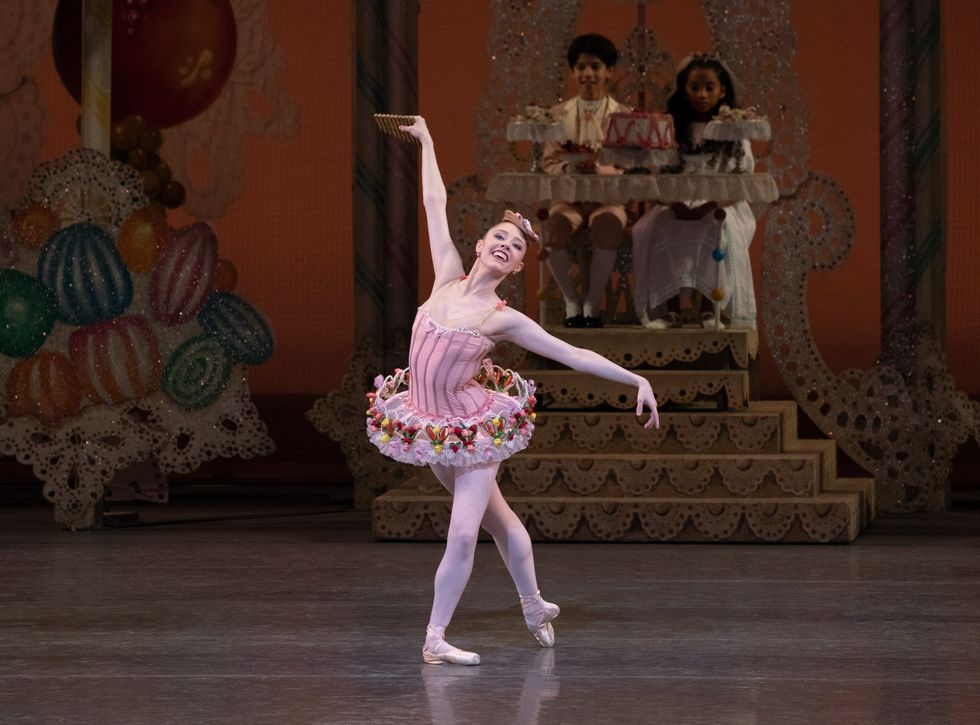 Kristin Segin as Lead Marzipan
Kristin Segin as Lead Marzipan
Erin Baiano, Courtesy NYCB
She adds that as a freelance artist, Nutcracker is a reliable source of work in an uncertain career. She still returns to her childhood studio, now The Hanover Theatre for the Performing Arts, to perform as a guest artist in The Nutcracker.
Likewise, freelance ballet dancer Eli Raphael Gruska booked his winter “quite intensely” last year, taking gigs performing Cavalier in three different Nutcrackers over the course of four weeks for a total of 14 shows. “It was a really great exercise for me to adapt, push through, find strength, work with different partners and pick up choreography,” he says. “And it really does help sustain a lot of dancers to do these Nutcracker gigs.”
Eliza S. Tollet, owner of The Ballet Spot, a ballet-focused online workout studio, finds taking Nutcracker jobs is a good way to build stamina and strength as a freelance dancer. “I really like the physical demands of Nutcracker, how you’re just dancing until you’re dead,” she says.
“More than anything, it’s a dancer development tool,” Nissinen, of Boston Ballet, says. “At the end of Nutcracker I have a tired company, but I have a better company.”
Beyond the toy soldiers and Sugar Plums who will miss debuts, Nutcracker plays a key role in building a bridge between smaller regional companies and elite professional ones, Fisher says. “It ties together communities in a way that doesn’t just sell tickets for the rest of the season, but it’s sort of a goodwill gesture, and it helps ballet itself grow,” she says.
A Welcome Intermission
There’s a reason why hearing Nutcracker music in an elevator or a department store can be startling for a dancer—the season can be nutty.
Veteran NYCB corps member Kristen Segin, who has performed Balanchine’s Nutcracker every year since she was a 12-year-old student at The Rock School for Dance Education, says, “It’s kind of really exciting, because this is the first Christmas holiday season that I’ll have more than just one day off.”
Typically, Segin averages more than 40 public Nutcracker performances every year from the day after Thanksgiving to around New Year’s Day. She usually performs Marzipan, cycling between the lead and corps roles, occasionally jumping into Snow and Flowers to cover for other dancers. It’s strenuous physically and mentally to go from rehearsals for new works during the day to Nutcracker at night, she says. “But I find comfort in it because it’s something very familiar.”
Nissinen is hopeful that his dancers will develop a new appreciation for the ballet after having it taken away. Nutcracker is “an incredible opportunity to get better,” he says. “If you have the right mentality, it’s a gift.”
After all, the amount of time offstage this season due to COVID-19 is similar to being sidelined for a major injury. “For dancers, losing a year is enormous in their career,” says Jean Grand-Maître, artistic director of the Alberta Ballet. “It could be up to 10 percent of their career time.” Dancers know they only have so many performing years. “Anything that prevents us from doing what we do is heightened because of the brevity of our career,” Kent says.
“Right now, if I had to perform Marzipan every day, I would jump at that chance,” Segin says. “Just to get back onstage again.”
